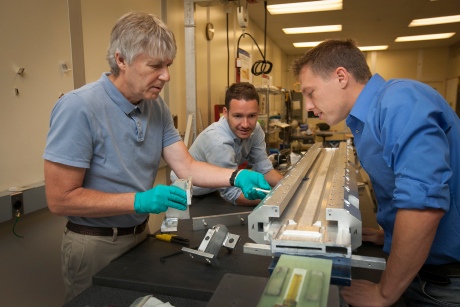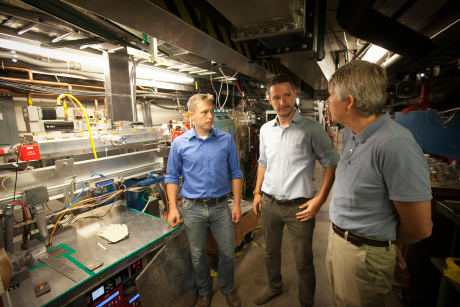Synchrotron upgrade to make X-rays even brighter
By Anne Ju

The X-rays produced by the Cornell High Energy Synchrotron Source (CHESS) are bright, but they will soon be even brighter, thanks to a major upgrade that will make the quality of CHESS’ X-rays competitive with the world’s best synchrotron light sources.
The upgrade involves replacing old magnetic devices called wigglers with smaller, better ones called undulators, outfitted along the beam pipe in CESR (Cornell Electron Storage Ring). As continuously circulating electron or positron beams shoot through the undulators, arrays of magnets inside wave the beams back and forth. It’s this movement that produces the X-rays needed for CHESS experiments.
“Undulators serve the same purpose as wigglers, but they will deliver much more X-ray intensity, and people will be able to do new experiments,” said CHESS senior research associate Alexander (Sasha) Temnykh, who has led the development of CHESS’ specially designed compact undulators.
CHESS, a National Science Foundation user facility, delivers these high-energy photons, or X-rays, to experiment stations located along different beam lines so that scientists can illuminate research samples. Just like doctors’ office X-rays penetrate the body, high-energy X-rays can peer deep into materials as hard as titanium.
The undulators will allow CHESS to deliver state-of-the-art X-rays for users, said Joel Brock, director of CHESS. For most experiments, getting as many X-rays as possible on as small a spot as possible is the goal. When a beam travels through the undulator, resultant radiation will be focused down to that small spot – like a laser pointer, as opposed to a flashlight, Brock said.

Undulators are growing in popularity at synchrotron facilities because they deliver several orders of magnitude higher flux, which is a measure of photon flow, than the older wiggler technology.
“It is hard to overstate the importance of this upgrade,” Brock said.
CHESS’ wigglers are 8-foot-long, bulky devices that weigh several tons and take up precious space in the CESR tunnel. While effective for producing synchrotron radiation, they also waste many photons as heat.
CHESS’ compact undulators are 10 times smaller and only weigh about 400 pounds, making them easier to work with. They produce about 20 times more X-rays for a given electron or positron beam energy, according to Temnykh. CHESS officials expect gains of up to 50 times more efficiency for X-ray experiments, which will result in shorter exposure times and more advanced experiments.
“All we want are useful photons on the sample,” said Aaron Lyndaker, CHESS engineer. “Wigglers produce an immense number of photons, many more than the undulators, but many fewer useful photons.”
Experiments that now take 20 hours of exposure time could be done in an hour. This could make a big difference for, for example, protein crystallographers, whose delicate samples can burn up easily due to X-ray overexposure. Or, scientists and artists who scan paintings for hidden artifacts would need less time with the damaging X-rays.
Faster, brighter X-rays could lead to major advancements for researchers like Matthew Miller, professor of mechanical and aerospace engineering and associate director of CHESS, whose group uses X-rays to observe changes in materials like titanium, nickel, copper and steel that can lead to cracks at the scale of individual crystals.
Using specially designed loading machines and detailed models of the materials’ microstructures, Miller’s group seeks to understand conditions for crack nucleation, and why materials eventually fail, by applying varying levels of force while hitting their samples with X-rays. Their goal is to develop new modeling tools for designing engineering components, based on the properties and deformation characteristics of single crystals.
The undulator upgrade would allow Miller to make 10 times more measurements of micro-deformations in a given period of time. That in itself would be a substantial change, he said.
“We can start thinking about making whole movies of each crystal within a deforming polycrystal,” Miller said. “With the ability to interrogate each of the thousands of individual crystals within a typical diffraction volume, the polycrystalline aggregate becomes an experimental test bed, and the statistical relevance could go through the roof.” Smaller X-ray beams would also provide greater detail of individual crystals in a metal.
“If things get so fast and small that I’m now rastering my sample like a scanning electron microscope, that’s a game changer,” Miller said.
Two prototype compact undulators have been tested so far in CESR, while CHESS has contracted with the Italy-based synchrotron device manufacturer Kyma to construct the permanent devices. The first such device should be installed in CESR around the beginning of November.
CHESS officials hope that a year from now, eight experiment stations will benefit from five compact undulators.
Media Contact
Get Cornell news delivered right to your inbox.
Subscribe